Insight into the photoexcitation effect on the catalytic activation of H2 and C-H bonds on TiO2(110) surface
Min Zhou,Hai-Feng Wang
Key Laboratory for Advanced Materials,Centre for Computational Chemistry and Research Institute of Industrial Catalysis,East China University of Science and Technology,Shanghai 200237,China
Keywords:Density functional theory calculation Photocatalysis H2 activation C-H bond activation TiO2
ABSTRACT Semiconductor photocatalysis holds great promise for breaking the inert chemical bonds under mild condition;however,the photoexcitation-induced modulation mechanism has not been well understood at the atomic level.Herein,by performing the DFT+U calculations,we quantitatively compare H2 activation on rutile TiO2(110) under thermo- versus photo-catalytic condition.It is found that H2 dissociation prefers to occur via the heterolytic cleavage mode in thermocatalysis,but changes to the homolytic cleavage mode and gets evidently promoted in the presence of photoexcited hole (h+).The origin can be ascribed to the generation of highly oxidative lattice O-radical (Obr·-) with a localized unoccupied O-2p state.More importantly,we identify that this photo-induced promotion effect can be practicable to another kind of important chemical bond,i.e.,C-H bond in light hydrocarbons including alkane,alkene and aromatics;an exception is the C(sp1)-H in alkyne (HC≡CH),which encounters inhibition effect from photoexcitation.By quantitative analysis,the origins behind these results are attributed to the interplay between two factors: C-H bond energy (Ebond) and the acidity.Owing to the relatively high Ebond and acidity,it favors the C(sp1)-H bond to proceed with the heterolytic cleavage mode in both thermo-and photo-catalysis,and the photoexcited Obr·- is adverse to receiving the transferred proton.By contrast,for the other hydrocarbons with moderate/low Ebond,the Obr·- would enable to change their activation mode to a more favored homolytic one and evidently decrease the C-H activation barrier.This work may provide a general picture for understanding the photocatalytic R-H (R=H,C) bond activation over the semiconductor catalyst.
The activation of H-H and C-H bonds (classified as R-H,R=H,C) is of vital importance in the hydrogenation and dehydrogenation processes for the catalytic conversion and functionalization of saturated or unsaturated hydrocarbon compounds.Ways to efficiently break these chemical bonds under mild condition are always at the heart of chemical industry [1-3],which constitutes one of the foundations for the controllable formation of value-added commodity [4-6].Generally,the catalytic cleavage and functionalization of R-H bond have been extensively explored on kinds of catalysts,such as the noble metals (Pt [7-9],Rh [10-12],Au [13,14]andet al.[15-18]),transition metal oxides (TMOs) and zeolites[19-21].For example,the TMO-catalysts modified by single-atom metal doping or metal loading [22-26]were specifically manufactured to tailor the catalytic activity toward R-H bond activation.Despite these great progresses,these reactions are often performed at high temperatures (573-873 K) [27-29],which could lead to severe coke deposition and low product selectivity.Therefore,it is of paramount importance to develop more efficient catalysts or technologies for R-H bond activation under mild condition [30-33].
In this regard,the photocatalytic technology is believed to be capable of altering the reaction kinetics under mild condition owing to the presence of the excited carrier (h+/e-),and increasing experimental studies have demonstrated the feasibility for facilitating the R-H bond activation [34-36].Taking the photocatalytic CH4activation as an example,it was proposed that CH4can be selectively converted to CH3OH or HCHO under UV irradiation at room temperature over semiconductor catalysts,like TiO2[37],ZnO [38]andet al.[39-41].However,the atomic-level insight into the photocatalytic effect is not unambiguously disclosed,to the best of our knowledge.Theoretically,owing to the difficulty in simulating photo-excited radicals properly on the semiconductor,the photocatalytic surface reaction has been relatively less studied with the detailed kinetic information provided [42-44].It seems that most researches mainly focus on thermodynamic properties to evaluate the photocatalytic activity by considering the band structure of semiconductor and the potential of target reaction[45-48].Kinetically,a comprehensive understanding of the nature of photocatalytic effect on R-H bond activation at the atomic-scale level is very limited.Specifically,one may ask,how does the photoexcitation affect the H2and C-H activation,and what is the quantitative difference between thermo-and photo-catalytic mechanisms? Moreover,there are different types of C-H bonds,e.g.,C(sp3)-H,C(sp2)-H and C(sp1)-H,and what are the general rule or difference of the photocatalytic effects on them?
Herein,we computationally explored the activation of H2molecule and diverse C-H bonds in thermo-and photo-catalysis on rutile TiO2(110),one of the most studied semiconductors in photocatalysis.The theoretical results explicitly revealed the reaction mechanisms of H2activation;moreover,the activation of C-H bonds in diverse light-hydrocarbons,including acetylene (HC≡CH),benzene (C6H5-H),ethylene (CH2=CH-H),methane (CH3-H),ethane (CH3CH2-H),propyne (CH≡CCH2-H),toluene (C6H5CH2-H)and propylene (CH2=CHCH2-H),were calculated and compared.The C-H bond energy (Ebond) and deprotonation energy (Edep,corresponding to the acidity) were identified to be two main factors leading to the distinct behaviors of R-H bonds activation in thermo-and photo-excited conditions.
All spin-polarized DFT calculations were performedviaVienna ad initio Software Package (VASP) code [49,50],using the Perdew-Burke-Ernzerhof (PBE) functional within the generalized gradient approximation (GGA) [51,52].The project-augmented wave (PAW)[53]method was used to represent the core-valence electron interaction,and the valence electronic states were expanded in plane wave basis sets with a cutoff energy of 450 eV.To ensure proper description of the valence electrons on Ti atom,a valence electron configurations 3p64s23d2(small core) was applied.
We adopted ap(3×2) model of rutile TiO2(110) with four TiO2atomic layers to accommodate the organic molecule and minimize the interaction between periodically repeated slabs.The vacuum between slabs was ~10 ˚A and a 2×3×1k-point mesh was used during the optimizations.The transition states (TSs) were searched by the constrained optimization scheme and were verified when (i) all forces on the atoms vanish and (ii) the total energy is a maximum along the reaction coordinate but a minimum with respect to the rest of the degrees of freedom [54-56].All the atoms were allowed to relax,until the force on each atom was less than 0.05 eV/˚A.The van der Waals forces was taken into account throughout this work to consider the possible weak interaction between intermediates and TiO2(110) surface [57,58].To model the photogenerated h+/e-,here we took the method of removing/adding electrons directly from the system with an additional neutralizing background charge applied in VASP due to the large dielectric constant of rutile TiO2[59].Moreover,the photogenerated carriers usually tend to delocalize on TiO2system in GGA calculations due to the self-interaction error.To overcome this issue,DFT+Umethod with an on-site Coulomb interactionUadded to the Ti-3d (U=4.2 eV) and O-2p orbitals (U=6.3 eV) was adopted for structure optimization and energy calculation [60],and the HSE06 hybrid functional was used to verify the electronic structure.Such an approach has been successfully applied to describe the photocatalytic reactions (e.g.,methanol oxidation,oxygen evolution reaction) on TiO2[61,62].
The adsorption energy of surface species (X) was defined asEad(X)=E(X/sur)-E(sur)-E(X),whereE(sur),E(X) andE(X/sur)are the energy of catalyst surface,X species in the gas phase and X species adsorbed on the catalyst surface,respectively.Notably,at a specific temperature,the large entropy contributions of gaseous molecules were considered to estimate the adsorption free energy(Gad) [63,64].
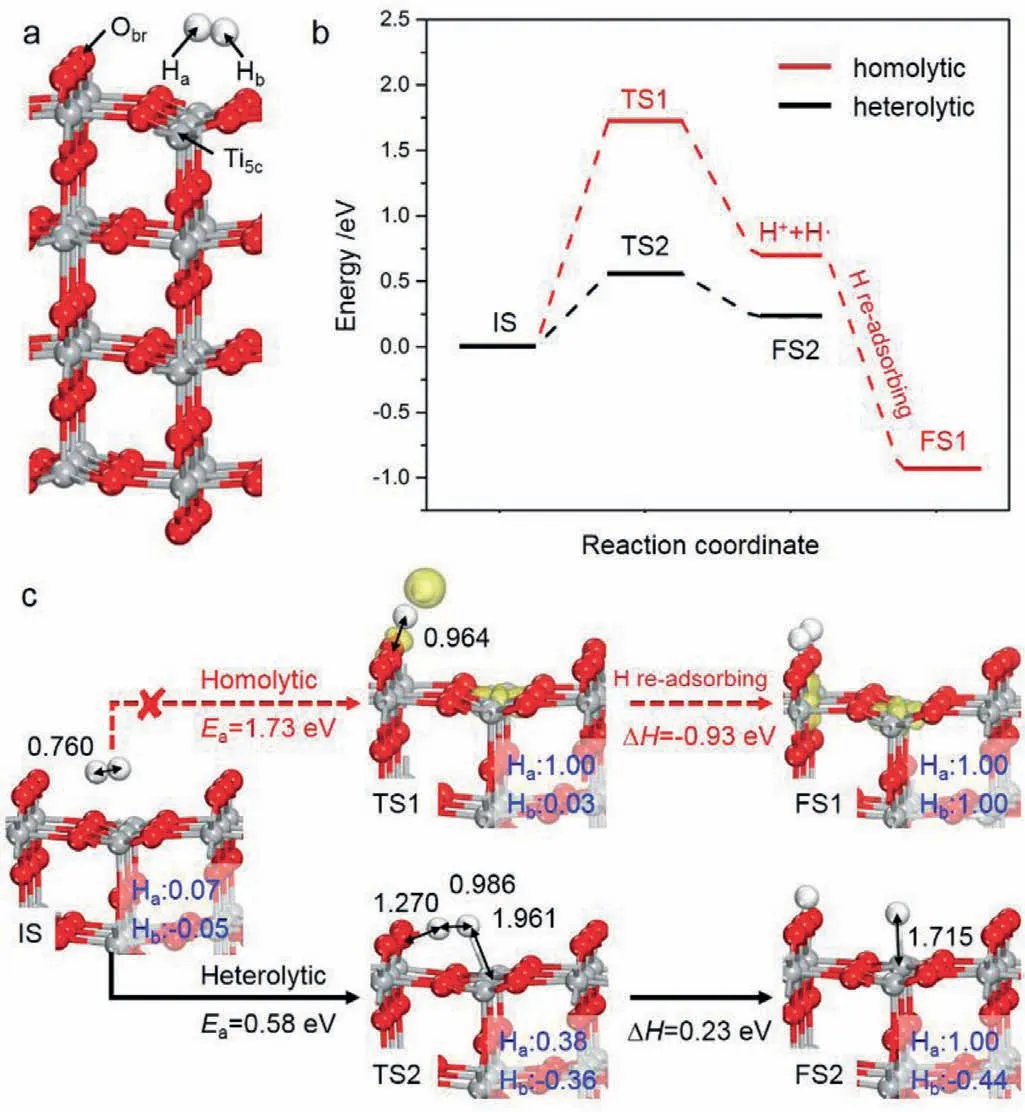
Fig.1.(a) Ball-and-Stick model of rutile TiO2(110) surface and H2 adsorption configuration,in which Ha is the H atom approaching to Obr site and the other H atom is named as Hb.(b) Energy profiles of thermo-catalytic H2 dissociation via homolytic and heterolytic modes,respectively,and (c) the optimized structures and spin density distribution of initial state (IS),transition state (TS) and final state (FS).The barrier (Ea) and enthalpy change (ΔH) are labeled (in eV).The distances of some key bonds and Bader charges of important intermediates are labeled in black(in ˚A) and blue (in |e|),respectively.Ti,gray;O,red;H,white.
As Fig.1a shows,the rutile TiO2(110) surface is terminated by two types of unsaturated sites: two-fold coordinated bridge O and five-fold coordinated Ti (denoted as Obrand Ti5c,respectively),which constitute the possible active centers for H-H and C-H bonds activation.Firstly,the adsorption and dissociation of H2molecule under the thermocatalytic condition were briefly examined as a benchmark.It was found that H2can weakly adsorb on Ti5csite with an adsorption energy,Ead(H2),of-0.20 eV,which corresponds to an adsorption free energy,Gad(H2),of 0.20 eV at room temperature.Subsequently,we tested two possible H2dissociation routes,including homolytic and heterolytic cleavage pathways,according to previous studies [30,31,65].In the homolytic mode,H2activation is accompanied by the formation of a H·and a H+(i.e.,H2+Ti5c4++Obr2-→H·+Ti5c3++ObrH-);the activation barrier is as high as 1.73 eV and the enthalpy change reaches 0.70 eV (see energy profiles in Fig.1b).Alternatively,when the reaction proceedsviathe heterolytic cleavage mode,which synergistically occurs at the Obrand Ti5cdual sites (i.e.,H2+Ti5c4++Obr2-→Ti5c4+-H-+ObrH-),the barrier decreases a lot to 0.58 eV.This indicates that the heterolytic mode is energetically more favorable for HH bond scission than the homolytic mode.Moreover,the H atoms dissociated from the heterolytic cleavage would be eventually captured by Obrand Ti5csites yielding a H+and a H-anion,evidenced by their Bader charges of 1.00 |e| and-0.44 |e| (Fig.1c),respectively.Notably,these barriers are slightly higher than those reported by Huet al.(1.39 eV and 0.37 eV in homolytic and heterolytic modes,respectively),owing to the self-interaction error of TiO2system ignored in their study [65].
Secondly,we calculated the photocatalytic H2dissociation on TiO2(110) surface.Generally,the generated photohole/electron pairs under light illumination thermodynamically tend to be trapped by Obrand Ti5csites and form Obr·-and Ti5c3+,respectively,corresponding to Obr2-+h+→Obr·-and Ti5c4++e-→Ti5c3+[66-68].As Figs.2a and b show,our calculations verify that these two excited active sites (Obr·-and Ti5c3+)have insignificant effect on H2adsorption withEad(H2) of-0.22 eV and-0.21 eV,respectively.With the assistance of Ti5c3+,the barrier of H2dissociation is nearly the same as that in thermocatalysis (0.56 eVvs.0.58 eV) with a very similar TS structure (see TS1 in Fig.2c),implying little contribution of photo-electron on H2activation.Intriguingly,on hole-trapped TiO2(110) surface,the TS of H-H bond cleavage changes from the dihapto configuration in the thermocatalytic condition to the monohapto one (Figs.2c and 1c),and the barrier is reduced to 0.37 eV with an enthalpy change of-0.04 eV (i.e.,H2+Obr·-→HObr-+H·).Notably,in comparison with the pristine homolytic cleavage mode in thermocatalysis,the barrier has largely declined (1.73 eVvs.0.37 eV).With the generation of H·radical,it would further re-adsorb on Obrand form H+with a large energy release (-2.90 eV).More specifically,in this photocatalytic TS,one H in H2molecule is captured by Obr·-and the other H suspends above the TiO2surface with the H···H and Ha···Obrbonds being 0.857 ˚A and 1.307 ˚A,respectively.In other word,it exhibits a radical-like TS,and the radical nature of H atom is also confirmed by Bader spin charge of 0.97 |e|.Therefore,the H-H bond activation mediated by photo-hole essentially follows the homolytic cleavage mechanism.
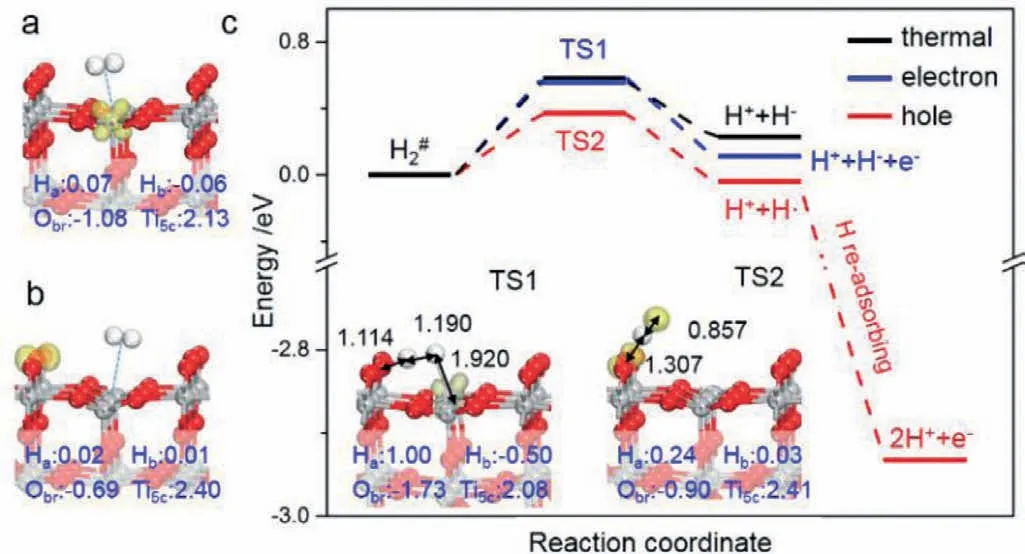
Fig.2.(a,b) H2 adsorption on TiO2(110) in the presence of Ti5c3+ and Obr·-,respectively.(c) Energy profiles of H2 dissociation in thermocatalysis via heterolytic mode (black line) or under light irradiation,including hole-and electron-assisted circumstances (red and blue lines,respectively).
To shed light on the promotion effect of photo-hole on H2dissociation,we quantitatively inspected the related electronic structure information.Firstly,the periodic natural bond orbital (NBO)[69]of two-site assisted TS complex in thermocatalysis was analyzed to uncover the bonding/antibonding nature of Ha-Obrand Hb-Ti5c(see Fig.3a),in which Ha/Hbdenotes the H atom in H2close to the Obr/Ti5csite,respectively (Fig.1a).Quantitatively,the charge of Hais calculated to be 0.65 |e| in the H2activation TS,indicating that the electron in Hais partially shared by the forming Ha-Obrbond;however,it owns a charge of 1.06 |e| for the Hbatom in Hb-Ti5cbond,implying the negligible electron transfer (versusthat (0.93 |e|) of Hbatom in pristine H2molecule).Moreover,the occupancy of Ha-Obrbonding/antibonding is 0.91/0.20 |e|,but nearly zero for Hb-Ti5cbond.Therefore,we can speculate that the activation of H2molecule depends mainly on the Obrsite,whereas the Ti5csite contributes to a small extent,which could well explain the greater promotion effect of photo-hole than photo-electron.Similar result can be drawn in the C-H bond activation of CH4molecule on rutile TiO2(110) surface [70].
Furthermore,the projected densities of states (PDOSs) of TiO2(110) in the absence or presence of Obr·-were calculated (see Figs.3b and c).It can be seen that the presence of localized photohole does not lead to significant change in the whole band gap,but induces a new unoccupied state within the forbidden band.In principle,this hole-state is conductive to accepting electron and exhibits strong oxidizability,evidenced by the higher energy level of Obr·-(~1.5 eV above the fermi level).In this sense,the superior performance of Obr·-than Obr2-on H-H bond rupture can be rationalized as follows.Obr·-holds less electron (-0.69 |e|) than Obr2-(-1.08 |e|),and this reactive Obr·-site,as a stronger oxidative center,can more easily accept electron from the dissociated hydrogen atom after H2homolytic cleavage in photocatalysis,thereby largely decreasing the activation barrier.
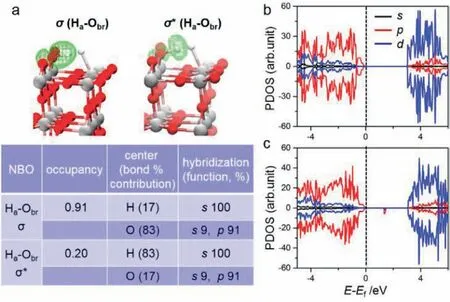
Fig.3.(a) The periodic natural bond orbital (NBOs) of TS for H2 dissociation in thermocatalysis via the heterolytic mode.(b,c) The projected densities of states (PDOSs) of pristine TiO2(110) and hole-trapping TiO2(110),respectively,using HSE06.The vertical dotted lines in the PDOSs denote the fermi levels.
With the understanding of photoexcitation effect on modulating H2dissociation,we are now at the position to explore the C-H bond activation in a series of different organic molecules on TiO2(110),aiming to uncover the general rule of the photohole effect,which includes (i) sp1-C group: HC≡C-H;(ii) sp2-C group: C6H5-H and CH2=CH-H;(iii) sp3-C group: CH3-H,CH3CH2-H,CH≡CCH2-H,C6H5CH2-H and CH2=CHCH2-H.At first,the thermally-driven C-H bond activation processes were studied.By comparing the barriers in homolytic and heterolytic cleavage modes (Table 1),we can see that heterolytic route is not always the most favorable one for all C-H bonds,which differs from H-H bond activation.In detail,the HC≡C-H,C6H5-H,CH2=CH-H,CH3-H and CH3CH2-H bonds prefer to be activatedviathe heterolytic cleavage mode,whereas the homolytic mode for the others (i.e.,CH≡CCH2-H,C6H5CH2-H and CH2=CHCH2-H) (Fig.4a and Table 1).Additionally,except for HC≡C-H (0.13 eV),almost all the reaction barriers of the most favored pathway are above 0.90 eV,which indicatesthe difficulty of C-H bond activation at room temperature.In the presence of Obr·-,we identified that the homolytic mode becomes more favored for C-H bonds in all but HC≡C-H (Table 1).Particularly,the activation barriers for the CH≡CCH2-H,C6H5CH2-H and CH2=CHCH2-H bonds are extremely small (<0.10 eV) as compared to those in the thermocatalytic condition;for the usually-known inert C-H bonds in benzene,ethylene and methane,the barriers can also be reduced to below 0.52 eV.Overall,these results imply that for all these C-H bond in light hydrocarbons,the photo-hole can prompt their activation evidently,except for HC≡CH molecule.
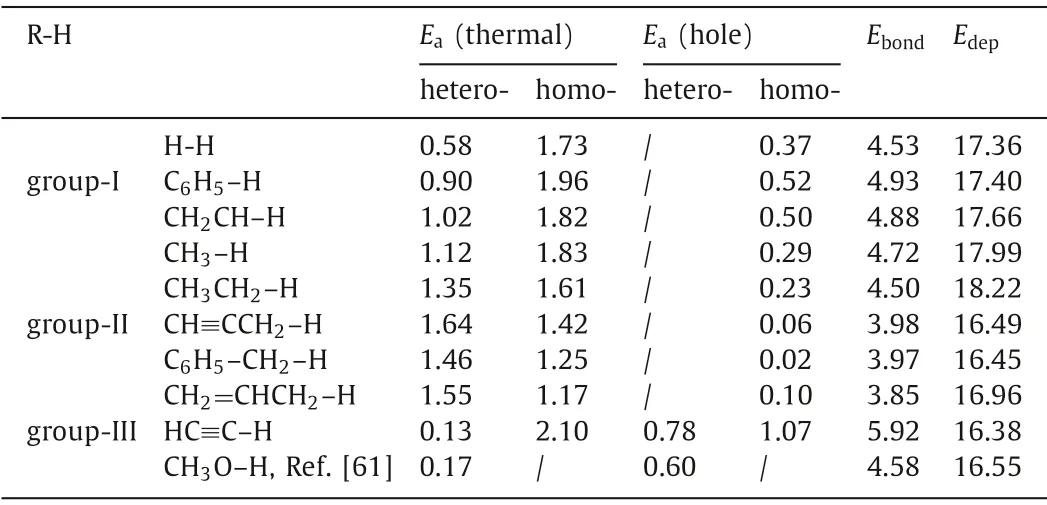
Table 1 Reaction barriers (Ea) of various R-H bonds cleavage on TiO2(110) in thermo-and photo-catalysis (heterolysis/homolysis,abbreviated as hetero-/homo-,respectively).Ebond is the R-H bond energy defined with the reaction energy of homolytic process(R-H →R·+ H·) and Edep is the deprotonation energy from the heterolytic process(R-H →R-+ H+),taken from the NIST WebBook [71].Note that the TSs of photocatalysis in heterolytic mode are hardly accessible in geometry,and thus their barriers are not shown here.The unit is eV.
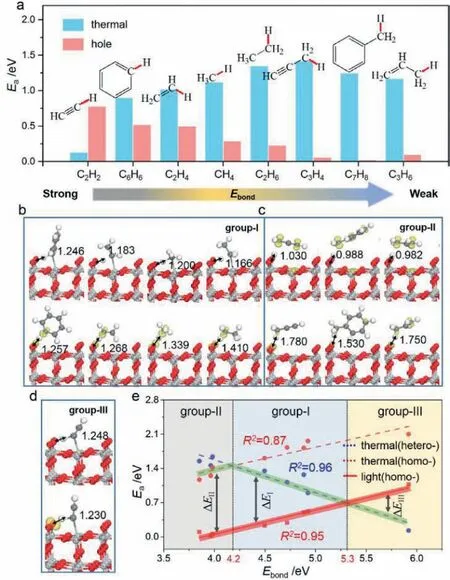
Fig.4.(a) Comparisons for the most favored activation barrier (Ea) of C-H bonds in the thermal and photo-hole assisted conditions,as well as the corresponding TSs for group-I,-II and-III C-H bonds (b-d),respectively,in which the distances of Ha···Obr bonds are labeled in black (in ˚A).(e) Correlations between Ea and Ebond in the thermal and photo-hole assisted conditions,respectively.
In addition,it is remarkable that the activation of these C-H bonds exhibits different behaviors,and is modulated by Obr·-to different degrees in comparison to the thermocatalysis (Fig.4a).According to the results revealed above,these C-H bonds may be,therefore,classified as three groups: (group-I) the ones (CH3-H,CH3CH2-H,CH2=CH-H and C6H5-H,Fig.4b) that follow the heterolysis mode in thermocatalysis and change to the homolysis mode in photocatalysis,to which the photo-effect is beneficial(seeΔEIin Fig.4e);(group-II) the ones (CH≡CCH2-H,C6H5CH2-H and CH2=CHCH2-H,Fig.4c) that follow the homolysis mode in thermocatalysis and keep it in photocatalysis,where the photoeffect is more efficient than group-I (seeΔEIIin Fig.4e);(group-III) HC≡C-H (Fig.4d),which prefers the heterolysis mode in both thermo-and photo-catalysis,and the presence of Obr·-will inhibit the HC≡C-H bond activation (seeΔEIIIin Fig.4e).One may naturally ask,what are the origins for these three different behaviors?Specifically,why do the group-II C-H bonds tend to follow the homolytic cleavage mode,differing from the others? For HC≡C-H,why does it always follow the heterolysis mode,and why is the presence of Obr·-adverse to its C-H bond scission?
Toward these questions,firstly,we quantitatively tested the dependence of theEavaluesviahomolytic/heterolytic routes in the thermocatalytic condition on the corresponding C-H bond energies (Ebond).Two overall linear relations can be obtained withR2of 0.87/0.96 (Fig.4e),respectively.More intriguingly,asEbondincreases,Eain the homolytic route increases,but decreases in the heterolytic one,and the crossing point of the two curves is atEbond=4.2 eV.These correlations clearly suggest that the choice of homolysisversusheterolysis in the thermocatalytic condition strongly depends on the C-H bond energy: the heterolysis is favored in the strong bond-energy region,while the homolysis is preferred in weak bond-energy region.For the group-II C-H bonds,they own the relatively weakerEbondamong all the studied ones (Table 1),due to the stability of dehydrogenated moleculefragment (i.e.,CH≡C-CH2·,C6H5-CH2·and CH2=CH-CH2·) with extendedπ-electron conjugation,which rationalizes the preference of homolytic cleavage in thermocatalysis.
With the participation of Obr·-in the C-H bond activation,a similar linear correlation exists between theEafollowing the homolysis mode in the photocatalytic condition andEbondas well(R2= 0.95,Fig.4e).One can see from Fig.4e that this line is overall downward shift in parallel as compared to that of the homolysis mode in the thermocatalytic condition,which again illustrates the promotion effect originating from the high oxidizability of Obr·-.Accordingly,we can explain the different promotion effect of Obr·-on the C-H bonds of group-Iversusgroup-II,which givesΔEII>ΔEI.For group-II C-H bonds,the homolytic mode is favored in both thermo-and photo-catalytic conditions,and the promotion extent (ΔEII) of Obr·-is the largest as seen from Fig.4e.Differently,for group-I C-H bonds,the heterolysis mode is more favored in the thermocatalytic condition,and it will change to the homolysis mode in photocatalysis;thus,the photo-promotion effect (ΔEI)is relatively weakened relative toΔEII.Moreover,it is worth noting thatΔEIbecomes smaller and smaller as theEbondincreases.
Secondly,as illustrated in Fig.4e,with the increase ofEbond,we can see that the thermodynamically driven heterolytic mode becomes more and more feasible.When above ~5.3 eV,it will be even more favored than the photo-driven process,essentially ascribed to that the localized hole at Obr·-cannot provide enough energy to compensate the C-H bond energy.Specifically for HC≡CH activation,the largeEbondof HC≡C-H is unfavorable for the occurring of homolytic mode.Moreover,as we know,HC≡CH together with the group-II molecules (CH≡CCH3,C6H5-CH3and CH2=CHCH3) displays weak acidity [72,73],consistent with their relatively small deprotonation energies (Edep) in Table 1.These two factors imply that the HC≡C-H is more susceptible to releasing hydrogen in the form of proton (i.e.,HC≡C-H →HC≡C-+H+).In this circumstance,the hydrogen in HC≡C-H would more easily combine with the Obr2-siteviaheterolysis rather than homolysis,which accordingly corresponds to a lower barrier of 0.13 eV(2.10 eV in homolysis).When the Obr·-is present,owing to the additional Coulomb repulsion between positively charged H+and Obr·-(versusthat in H+···Obr2-),the activation process is kinetically less favored than that in the pristine Obr2-(0.78 eVvs.0.13 eV in photo-and thermo-catalysis,respectively).Thus,the HC≡C-H bond prefers to be activated through the heterolytic mode and photo-hole would suppress this activation process,as a result of its strong bond energy and acidity.Notably,the similar result was also observed in the heterolytic O-H bond cleavage in the photocatalytic CH3OH oxidation revealed in our previous study (Table 1)[61].
In summary,we have quantitatively studied the activation mechanism of H2and a series of C-H bonds on TiO2(110) in the thermo-and photo-catalytic conditions,aiming to reveal the general photoexcitation effect on modulating the chemical bonds breakage.The main results can be summarized as follows:
(i) The thermal-driven H2activation on TiO2(110) tends to obey the heterolytic cleavage mode,and the Obr·-radical formed from the photo-hole localization would change the mode to be homolytic one and evidently facilitate the activation process.
(ii) We identified that the examined C-H bonds can be classified as three groups in terms of the bond energy and acidity: group-I (CH3-H,CH3CH2-H,CH2=CH-H and C6H5-H),group-II (CH≡CCH2-H,C6H5CH2-H and CH2=CHCH2-H) and group-III (HC≡C-H).The bond energy order is group-II<group-I<group-III;meanwhile,group-II/-III C-H bonds own weak acidity.The Obr·-species can facilitate the activation of group-I/II C-H bonds to different degrees,whereas inhibits the one in HC≡C-H.
(iii) The different C-H activation behaviors in group-I to group-III could be largely attributed to the C-H bond energies and acidities.For the group-I/-II C-H bonds with relatively moderate/low bond energies,they obey the heterolytic/homolytic cleavage mechanism in thermocatalysis,and will uniformly obey the homolysis mechanism driven and simultaneously promoted by the highly oxidative Obr·-,where the promotion effect on group-II C-H bonds is more evident with nearly negligible barriers.
(iv) Owing to the strong bond energy and weak acidity,we found that the HC≡C-H bond consistently prefers to be activatedviathe heterolytic cleavage mode,and Obr·-would inhibit this activation as a result of additional Coulomb repulsion between the dissociated proton and Obr·-(versusthe pristine Obr2-on TiO2(110)).
This work provided a general atomic-level description on the photo-versusthermo-catalytic activation of H2and various C-H bonds,which may explicitly deepen our understanding of the photocatalytic effect on modulating the chemical bonds breakage.
Declaration of competing interest
The authors report no declarations of interest.
Acknowledgments
This project was supported by National Nature Science Foundation of China (Nos.21873028,91945302),National Ten Thousand Talent Program for Young Top-notch Talents in China,Shanghai Shu-Guang project (No.17SG30),and the Fundamental Research Funds for the Central Universities
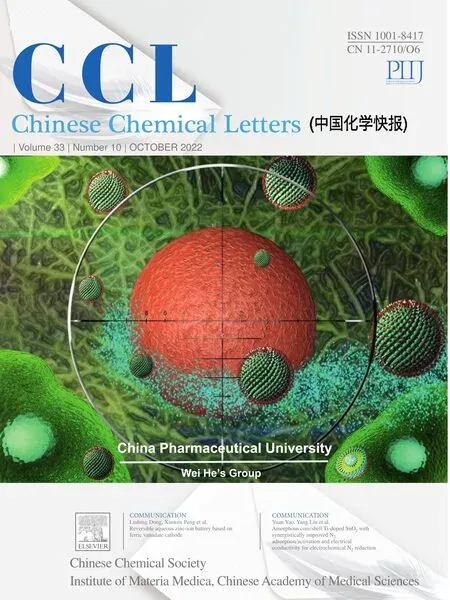 Chinese Chemical Letters2022年10期
Chinese Chemical Letters2022年10期
- Chinese Chemical Letters的其它文章
- An odyssey of lithium metal anode in liquid lithium-sulfur batteries
- Recent progress on preparation and applications of layered double hydroxides
- Two-dimensional transition metal chalcogenide nanomaterials for cancer diagnosis and treatment
- Emerging nanomedicine and prodrug delivery strategies for the treatment of inflammatory bowel disease
- Recent advances in persulfate-based advanced oxidation processes for organic wastewater treatment
- Recent advance of fluorescent probes for detection of drug-induced liver injury markers
